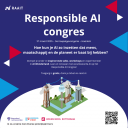Generative AI is dominating the news, how does it work, what are known applications an limitations. After an introduction into the domain, we would like to discuss the opportunities & threats with you.
Introduction to large language Models (incl generative chat like ChatGPT) & discussion opportunities & Threats





